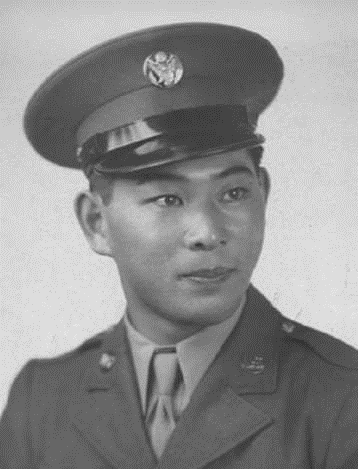
Kenichi Tsumaki
Private First Class
442nd Regimental Combat Team
3rd Battalion, K Company
Kenichi Tsumaki was born April 16, 1920, in McCammon, Idaho. He was one of three sons born to Kameichi Kamura and Kimi (Hori) Tsumaki. His brothers were Minoru A. and Shiro. Kamura and Kimi emigrated from the town of Mino, Shizuoka Prefecture, Japan. Kimi arrived in Vancouver, British Columbia, in 1906. Kamura was already living in McCammon, Idaho, and Kimi joined him there. The parents returned to Japan in the late 1920s, taking their sons with them. Kenichi returned to San Francisco on the Chichibu Maru, arriving on April 22, 1937. He went on to Pocatello, Idaho, where he worked for H. K. Kawamura on his farm. Brother Minoru returned on the Asama Maru, arriving in San Francisco on June 16, 1940. Both parents and brother Shiro remained in Japan.
Kenichi registered for the draft on July 1, 1941, at the Local Board in Bannock County, Pocatello, Idaho. His point of contact was his employer H. K. Kawamura, and his occupation was “Farm Hand.” He was 5’7” tall and weighed 155 pounds.
On March 16, 1942, Kenichi enlisted in the U. S. Army at Fort Douglas, Utah. He had completed four years of high school. He was sent to basic training at Camp Robinson, Arkansas, with a follow-on assignment to Fort McClellan, Alabama, for infantry training. In March 1943, he was transferred to Camp Shelby, Mississippi, and assigned to the 442nd Regimental Combat Team, 3rd Battalion, K Company.
After a year of basic and specialized training and military exercises, they left by train for Camp Patrick Henry, Virginia, on April 22, 1944. On May 2, the 442nd left nearby Hampton Roads in a convoy of over a hundred ships, and arrived at Naples, Italy, on May 28.
The battalion spent a week at a staging area in Bagnoli, near Naples, before leaving on LSTs for Anzio on June 6, where they marched five miles to a bivouac area. From Anzio, the 442nd went to a large bivouac area near Civitavecchia, north of Rome, where they went through additional training and final preparations for going to the front lines. The 442nd entered combat on June 26 near Suvereto in the Rome-Arno Campaign.
Kenichi fought in all battles of the 442nd in Italy before the Combat Team left for France on September 27, 1944. Once they arrived in Marseilles, they were in a bivouac area in nearby Septèmes until October 9, when they were transported north to participate in the Rhineland-Vosges Campaign. In October-November, the 442nd liberated the important rail and road junction of Bruyères, followed by Belmont and Biffontaine and the famous “Rescue of the Lost Battalion” – the 1st Battalion of the 141st (Texas) Infantry Regiment – that had advanced beyond its support, become surrounded by the enemy, and was unable to extricate itself.
After several days of severe fighting, on October 30, the Lost Battalion was rescued. It came at great loss for the 442nd soldiers, with very high casualties. The initial objective of the Texas “Lost Battalion” had been to clear the Germans from the entire long mountain ridge where it had become surrounded – and the 442nd’s 3rd Battalion was ordered to push on down to the end of this ridge. On November 7, Private First Class Kenichi Tsumaki was killed during this action.
The fighting would go on until November 9. The German line was completely shattered, but 442nd losses were so great that the Combat Team was temporarily ineffective as a fighting force.
Pfc. Tsumaki was buried in the U. S. Military Cemetery in nearby Epinal, France.
For his military service, Private First Class Kenichi Tsumaki was awarded the Silver Star Medal, Bronze Star Medal, Purple Heart Medal, American Campaign Medal, European-African-Middle Eastern Campaign Medal with two bronze stars, World War II Victory Medal, Distinguished Unit Badge, and Combat Infantryman Badge. He was awarded the Congressional Gold Medal on October 5, 2010, along with the other veterans of the 100th/442nd Regimental Combat Team. This is the highest Congressional Civilian Medal.
On February 7, 1945, Tsumaki was posthumously awarded the Silver Star by General Order No. 6, Headquarters 6th Army Group. The citation reads:
For gallantry in action in France on 29 October and 7 November 1944. When his company’s radio was damaged by enemy hand grenade fragments, Private First Class Tsumaki volunteered to carry a new one to the forward company. Though the artillery shells were falling along the supply route, he valiantly moved forward toward the front lines, crawling through enemy small arms fire for the last 75 yards to successfully reach his destination. On 7 November 1944, when the company was badly in need of ammunition, he voluntarily carried the boxes of ammunition for a distance of 150 yards through heavy enemy fire to the front lines.
Fatally wounded shortly after delivering the ammunition, Private First Class Tsumaki was an inspiration to his comrades and by his courage, determination, and gallantry reflects much credit upon himself and the United States Army. Next of kin: Minoru Tsumaki (brother) Pocatello, Idaho.
In 1949, the Tsumaki family had the choice to have their son returned, or remain at Epinal. They chose to have him returned to Japan. The ashes of Pfc. Kenichi Tsumaki were presented to his father, Kameichi Tsumaki of Shimizu, Japan, in a ceremony at the Minato Hotel in Tokyo.
Researched and written by the Sons & Daughters of the Regimental Combat Team in 2022.
